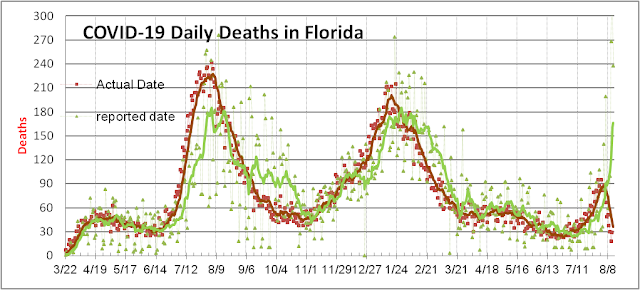Austrian and German Mortality Rates Appear Low
Austria and Germany are both suffering exponential growth of
confirmed COVID-19 cases. They are being
infected as fast or faster than any other country in the world. In fact, Austria now has a hotness index of
183 meaning that 183 per million of its population have now been confirmed with
COVID-19. Germany is close behind with
143 per million. But their
mortality rates have remained remarkably low.
The coincident mortality rates for Austria and Germany are 0.24% (with
95% confidence range of 0.09% - .65%) and 0.23% (0.16% - .35%). But these estimates are clearly too low
because as we have explained before in the exponential growth phase of a
pandemic, the coincident mortality rate is always too low. Few cases go from diagnosis to death in just
one day. Even though some cases are diagnosed
after death, most take 3-10 days to resolve themselves either as cures or
deaths. The full range of days from diagnosis
to death may be -2 to 21 days. We have modeled
dozens of countries’ death rates and find that the death count compared to the
number of confirmed cases 3-7 days before provides the most stable
forecast. We call this the lagged5
mortality rate. The lagged5 mortality rate for Austria is 0.8%
(0.3% - 2.1%) and 0.8% for Germany (0.5% - 1.1%). These are significantly lower than the current
WHO estimate of 3.4% and rules that out as statistically improbable for Austria
and Germany. Soon we can test whether it
is lower than the optimistic rate of 1.0% estimated by many scientists as the
true underlying mortality rate. We have also ruled the theory that COVID-19 is just like bad common
flu. For a long time the Germans (and
Americans and Brits and others) have been willing to let the virus run amok in
their country because they thought it was just like a severe common flu. In fact, Angela Merkel did not come out and
make a strong warning
until 3/11. Now that the Germans know better they
are finally taking drastic measures to try to curb the spread in their country
and the EU.
The question to ask is why do they seem to tolerate the coronavirus better any other country. Italy’s high 16% lagged5 mortality rate may be partially understood in terms of its high median age. Poorer healthcare systems in Italy, Iran, and Spain could account for the high lagged mortality rate seen in those countries. For example, Germans have 8900 hospital beds per million citizens compared to 4400 per million for Italy. One other major factor that can affect our estimated mortality rate is testing. The faster and more thoroughly a country test for COVID-19, the longer the time from diagnosis to case resolution. For example, soon after South Korea identified that the coronavirus was inside their country they rolled out extensive testing countrywide. Thus, both their coincident and lagged5 mortality rate is a low 1.0% and 1.1%, respectively. Being able to identify the true number of infections allows them to have a good fix on the denominator of the mortality rate and requires that we use a longer lag time between diagnosis and resolution for our estimates. If we assume that the time lag was longer than 5 days in Austria and Germany, the mortality rates would have to be adjusted higher. We think it is too early to make a definitive call. But we think we can safely conclude that the true COVID-19 mortality rate is not 3.4% or 0.3%, but rather something closer to 1% or lower. Extenuating factors such as an older population and overwhelmed medical facilities can drive this rate higher than 1%.
The question to ask is why do they seem to tolerate the coronavirus better any other country. Italy’s high 16% lagged5 mortality rate may be partially understood in terms of its high median age. Poorer healthcare systems in Italy, Iran, and Spain could account for the high lagged mortality rate seen in those countries. For example, Germans have 8900 hospital beds per million citizens compared to 4400 per million for Italy. One other major factor that can affect our estimated mortality rate is testing. The faster and more thoroughly a country test for COVID-19, the longer the time from diagnosis to case resolution. For example, soon after South Korea identified that the coronavirus was inside their country they rolled out extensive testing countrywide. Thus, both their coincident and lagged5 mortality rate is a low 1.0% and 1.1%, respectively. Being able to identify the true number of infections allows them to have a good fix on the denominator of the mortality rate and requires that we use a longer lag time between diagnosis and resolution for our estimates. If we assume that the time lag was longer than 5 days in Austria and Germany, the mortality rates would have to be adjusted higher. We think it is too early to make a definitive call. But we think we can safely conclude that the true COVID-19 mortality rate is not 3.4% or 0.3%, but rather something closer to 1% or lower. Extenuating factors such as an older population and overwhelmed medical facilities can drive this rate higher than 1%.



Comments
Post a Comment